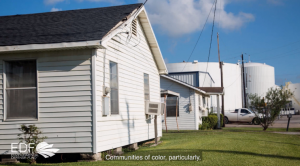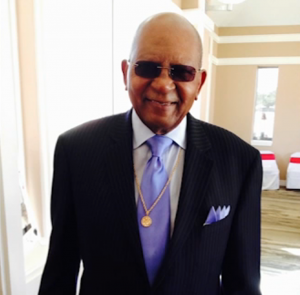
Hurricanes Coming: Protecting Black and Brown Neighborhoods from a “Triple Whammy”
Elena Craft, Ph.D., is Senior Director of Climate and Health
This is the first in a series of Global Clean Air blogs on COVID-19 and air pollution. EDF scientists will share data about pollution levels during quarantine from a local and global perspective, and provide recommendations for governments and companies to Rebuild Better.
A black man who lived most of his 88 years in Pleasantville was one of the first Houstonians to die from COVID-19.

His name was James C. Campbell. He raised a family in one of the first neighborhoods in the city planned for black Houstonians, Pleasantville, which has been surrounded in the years since it was founded by congested interstates, salvage yards, metal recyclers, and a sprawling brewery where heavy trucks come and go day and night. Pleasantville residents still share stories about where they were when chemicals in warehouses exploded in the 1990s and forced them to flee their neighborhood for safety.
Just days after Campbell’s funeral in early April, as the coronavirus started to spread across Texas, UT Health researchers mapped neighborhoods across Houston like Pleasantville where residents suffering from underlying health conditions and from years of exposure to air pollution were at increased risk from the worst impacts of a COVID infection. The intention was clear: Data could help local government leaders decide how, and where, to marshal resources to protect the health of those who needed it most.
Disasters do not impact neighborhoods equally, data like that show. It’s clear during the coronavirus pandemic, just as it was clear during past disasters like Hurricane Harvey. In 2017, for example, in the first, and worst days of the storm, 93 percent of all known toxic emissions in all of Harris County were released within a four-mile radius of the predominantly Hispanic neighborhood Manchester — an area that includes Pleasantville — even though it makes up less than 5 percent of the county geographically.
[pullquote]The pandemic is bringing into sharp focus the unacceptable health inequities in communities of color and low wealth across the nation.[/pullquote]
Whether it’s a virus or a hurricane, an explosion or chemical disaster, the more we know about the threats communities face, the more we will be able to understand how they might be harmed and the better we will be positioned to respond where the needs are greatest.
During the pandemic, public officials and scientists like me have spent hours studying the data on COVID-19 dashboards, including those for Texas, New York and the Centers for Disease Control and Prevention (CDC). These data sources provide clear evidence that communities of color and low wealth, once again, are the ones bearing the brunt of the latest disaster.
My research builds upon the body of knowledge that began with the work of Texas Southern University professor Robert D. Bullard in the late 1970s, which revealed Black and Latino communities already face an enormous and unequal burden of chronic exposure to air pollution. They are most likely to live near the very same oil refineries, chemical facilities, concrete batch plants, salvage yards and freeways that are found in and around Pleasantville and Manchester. They also are more likely to have riskier jobs and less access to health care and insurance.
Houston area governments quickly moved to help low-income residents
That is why elected leaders in Harris County, which includes Houston, made $30 million available through the COVID-19 Relief Fund for low-income residents to meet their basic needs, like food, shelter and medical care. The county uses data about COVID-19 infection rates, eviction, job losses, poverty and social vulnerability to identify neighborhoods for targeted outreach.
“Looking out for our most vulnerable residents is why government exists,” Harris County Commissioner Rodney Ellis wrote in a Houston Chronicle op-ed about the fund.

Without seeing how these crises are deeply interrelated, governments simply can’t protect people’s health and wellbeing.
Early on during Harvey in 2017, Houston’s 311 hotline received dozens of calls from Manchester residents reporting nausea and dizziness, even in a neighborhood where those symptoms are often triggered on ordinary days by the recklessness of oil refineries and chemical plants that have set up shop on the other side of their fences. In partnership with the Houston Health Department and Air Alliance Houston, I dispatched a team with advanced mobile air monitoring equipment to begin to understand what was going on and what they were breathing. But that effort just couldn’t scale up enough to grasp the impacts at a regional level, because local, state, and federal agencies were unprepared to protect the communities most in harm’s way.
EDF recognizes the need to do more. We found that the impacts of the disaster were simply not being understood in a way that was granular enough for regional leaders to be strategic and decisive about the prioritization of resources. We partnered with Rice University and a number of government agencies in the region to create the Texas Flood Registry.
Since the registry launched in 2018, more than 25,000 residents have taken the time to provide crucial demographic, economic, and physical and mental health information that is helping leaders understand where the disparities are and how to identify where resources are most needed.
Early health registry data shows similar connections to hurricane impacts
We have replicated this approach during the pandemic, and almost 6,000 people have already registered. Early findings show a huge gap between the number of people with symptoms and those being tested. They also reveal that nearly 25 percent of black households are having trouble paying the bills, compared with 8 percent of white ones. A hurricane this season — one forecasted to be more active than usual — would simply be too much for so many already living on the edge.
Together, these projects suggest the raw power of systematic, collaborative efforts to collect, analyze, and distribute data to all who can use it for good — and the massive potential to reshape the ways that all levels of government make decisions. Taking full advantage of this power and potential, though, will require an approach too many governments haven’t tried. It will require investments in time, talent, and technology too many governments haven’t made.
Now’s the time to make them. Now’s the time to try them. The pandemic is bringing into sharp focus the unacceptable health inequities in communities of color and low wealth across the nation. Even without the pressing threat of COVID-19, these communities face reduced life expectancy and worsening health outcomes because of political and economic decisions beyond their control, as Daniel E. Dawes, professor of health law and policy at Morehouse College, details in his book, “The Political Determinants of Health.”
One tool that can help governments break down these systemic barriers, give communities back more control and make sure that all can thrive is high-quality, actionable data. There’s simply no excuse now not to do all we can to equip ourselves with life-saving information — and then put it to work to begin saving lives.










